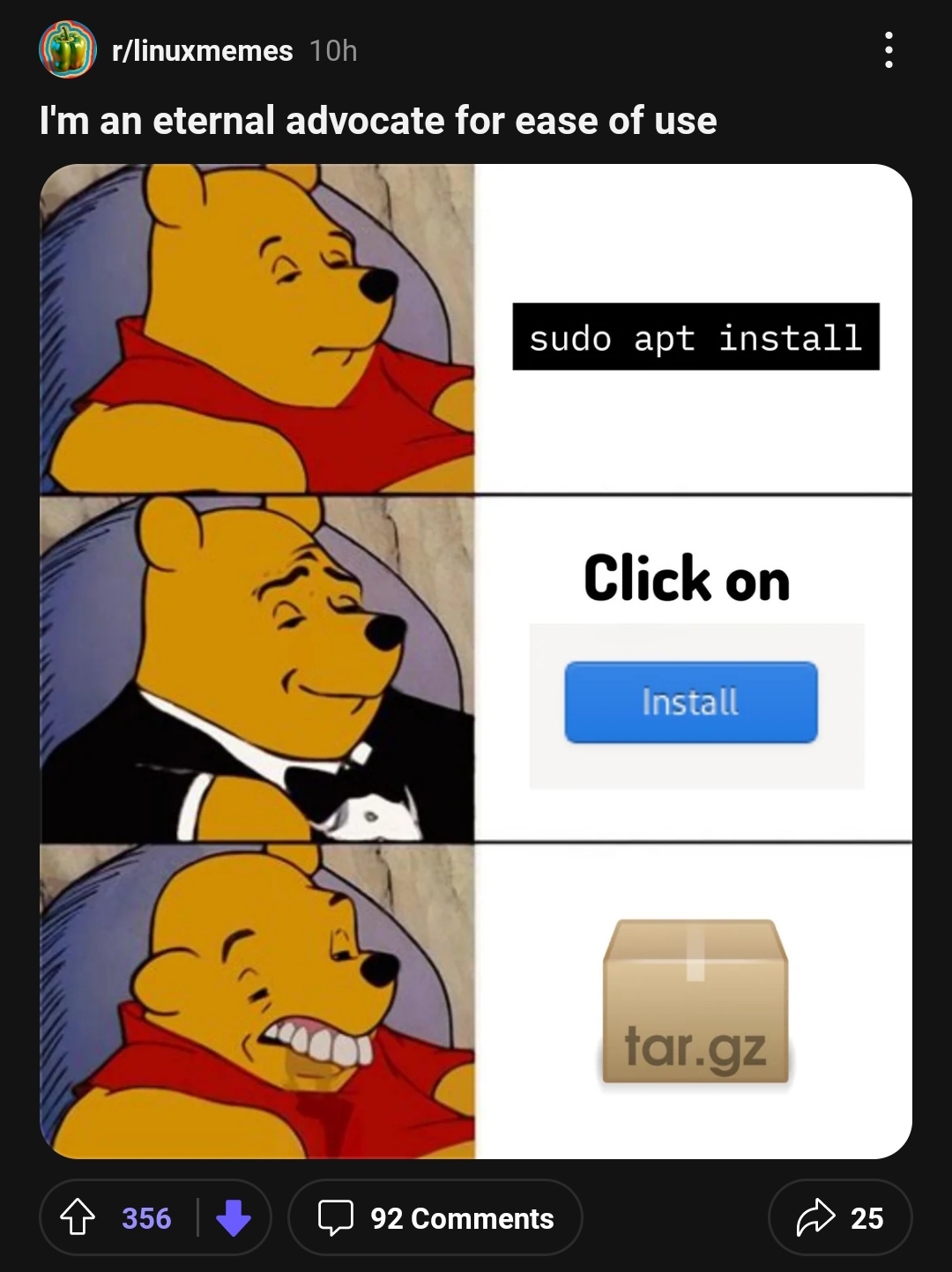this post was submitted on 06 Jan 2024
36 points (60.1% liked)
linuxmemes
21180 readers
873 users here now
Hint: :q!
Sister communities:
- LemmyMemes: Memes
- LemmyShitpost: Anything and everything goes.
- RISA: Star Trek memes and shitposts
Community rules (click to expand)
1. Follow the site-wide rules
- Instance-wide TOS: https://legal.lemmy.world/tos/
- Lemmy code of conduct: https://join-lemmy.org/docs/code_of_conduct.html
2. Be civil
- Understand the difference between a joke and an insult.
- Do not harrass or attack members of the community for any reason.
- Leave remarks of "peasantry" to the PCMR community. If you dislike an OS/service/application, attack the thing you dislike, not the individuals who use it. Some people may not have a choice.
- Bigotry will not be tolerated.
- These rules are somewhat loosened when the subject is a public figure. Still, do not attack their person or incite harrassment.
3. Post Linux-related content
- Including Unix and BSD.
- Non-Linux content is acceptable as long as it makes a reference to Linux. For example, the poorly made mockery of
sudoin Windows. - No porn. Even if you watch it on a Linux machine.
4. No recent reposts
- Everybody uses Arch btw, can't quit Vim, and wants to interject for a moment. You can stop now.
Please report posts and comments that break these rules!
founded 1 year ago
MODERATORS
you are viewing a single comment's thread
view the rest of the comments
view the rest of the comments

Being real, why DON'T distros just have the ability to do the installation if you double-click whatever file is downloaded?
I feel like we should have either option - download and double-click or just use the command line.
I mean, what else would double-clicking a .tar.gz file or an appimage do than install it (yes, I know, look into the archive, but really - how often is that the desired thing to do)? So, therefore, why don't we just have it install the files that are downloaded?
This is a legit question btw, I really don't know the answer
Cause .tar.gz is not an executable binary in itself. It is more like a zip of the binary and its support files. Since it would be really difficult to distribute and maintain native binaries for every type of distro, application publishers used to just distribute for distros that has a larger userbase, like a .deb for Debian/Ubuntu and a .rpm for Fedora/RHEL/Suse, and then they would provide a tarball for any other distro. Flatpak and Snap have been introduced to eliminate this overhead from application developers, but they still offer tarballs as the newer solutions are still far from standardization.
I 100% get that (and I know it's an archive), but I'm just saying why doesn't double-clicking a .tar.gz just run "tar xf file.tar.gz | sh" on that file? Or check if there's an executable in the extracted files and then run it if there is, and if it's just an archive of files then open the extracted folder?
What if I don't want to install it, even if there is a binary in there? What if I just wanna open the archive and see it's content?
The OS does the smart thing. The header says it's an archive, so we treat it as just that, an archive. Commercial OSes like Windows and MacOS are the oddballs out, not Linux. It just interprets the cold hard truth - this is an archive, I have no idea what's in it, you tell me what to do with it, end of story.